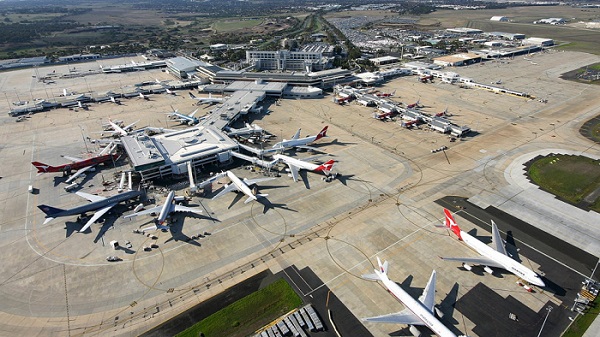Melbourne Airport

Melbourne Airport (IATA: MEL, ICAO: YMML), informally known as Tullamarine Airport, is the essential air terminal serving the city of Melbourne, and the second most active air terminal in Australia. It opened in 1970 to supplant the close by Essendon Airport. Melbourne Airport is the super global air terminal of the four air terminals serving the Melbourne metropolitan region, the other worldwide air terminal being Avalon Airport.
The air terminal contains four terminals: one worldwide terminal, two homegrown terminals and one spending plan homegrown terminal. It is 23 kilometers (14 miles) northwest of the downtown area, nearby the suburb of Tullamarine. The air terminal has its own suburb and postcode—Melbourne Airport, Victoria (postcode 3045).
In 2016–17 around 25 million homegrown travelers and 10 million worldwide travelers utilized the air terminal. The Melbourne–Sydney air course is the third most-voyaged traveler air course on the planet. The air terminal highlights non-stop trips to 33 homegrown objections and to objections in the Pacific, Europe, Asia, North America and South America. Melbourne Airport is the main appearance/flight point for the air terminals of four of Australia’s seven other capital urban communities. Melbourne fills in as a significant center point for Qantas and Virgin Australia, while Jetstar uses the air terminal as headquarters. Locally, Melbourne fills in as base camp for Australian airExpress and Toll Priority and handles more homegrown cargo than some other air terminal in the country
Foundation
Before the launch of Melbourne Airport, Melbourne’s fundamental air terminal was Essendon Airport, which was formally assigned a global air terminal in 1950. During the 1950s, more than 10,000 travelers were utilizing Essendon Airport, and its impediments were starting to become obvious. Essendon’s offices were lacking to fulfill the expanding need for air travel; the runways were too short to even consider taking care of planes, and the terminals neglected to deal with the increment in travelers. By the mid-1950s, a global flood terminal was inherent another northern shed. The air terminal couldn’t be extended, as it had become encircled by private regions.
The quest for a swap for Essendon started in February 1958, when a board was delegated to evaluate Melbourne’s thoughtful aeronautics needs. Elective locales considered were Tullamarine (12 miles from Melbourne), Whittlesea (18 miles), Hastings (40 miles), Port Melbourne (3 miles), Werribee (25 miles), Laverton (16 miles), Avalon (35 miles) and Moorabbin (14 miles).Considerations, for example, better closeness than Melbourne and lower improvement costs restricted the decision to either Tullamarine or Laverton, with Laverton in the end disposed of to some extent because of issues organizing both military and common exercises that couldn’t ensure the level of security requested, and that traffic coordination would be more straightforward with the more limited distance among Essendon and Tullamarine.
In 1959, the Commonwealth Government obtained 5,300 ha (13,000 sections of land) of field in then-rustic Tullamarine.
In May 1959 it was reported that another air terminal would be worked at Tullamarine, with Prime Minister Robert Menzies declaring on 27 November 1962 a five-year intend to furnish Melbourne with an A$45 million “jetport” by 1967. The primary grass at Tullamarine was turned two years after the fact in November 1964. In accordance with the five-year plan, the runways at Essendon were extended to deal with bigger airplane, with Ansett Australia sending off the Boeing 727 there in October 1964, the principal stream airplane utilized for homegrown air travel in Australia.
On 1 July 1970, Prime Minister John Gorton opened Melbourne Airport to worldwide activities finishing Essendon’s close to multi decade run as Melbourne’s global air terminal. Essendon actually was home to homegrown trips for one year, until they moved to Melbourne Airport on 26 June 1971, with the main appearance of a Boeing 747 happening sometime thereafter. In the main year of activities, Melbourne dealt with six worldwide carriers and 155,275 global travelers.
Melbourne Airport was initially called ‘Melbourne International Airport’. It is at Tullamarine, a name got from the native name Tullamareena. Locally, the air terminal is ordinarily alluded to as Tullamarine or basically as Tulla to recognize the air terminal from the other three Melbourne air terminals: Avalon, Essendon and Moorabbin.
On opening, Melbourne Airport comprised of three associated terminals: International in the middle, with Ansett toward the South and Trans Australia Airlines toward the North. The plan limit of the air terminal was eight Boeing 707s at a pace of 500 travelers each hour, with minor development works finished in 1973 permitting Boeing 747s to serve the air terminal. By the last part of the 1980s top traveler streams at the air terminal had reached 900 every hour, causing significant clog.
In late 1989, Federal Airports Corporation Inspector A. Rohead was placed accountable for a bicentennial task to rename roads in Melbourne Airport to respect the first occupants, European trailblazers and avionics history. Data on the initial two classifications was given by Ian Hunter, Wurundjeri scientist, and Ray Gibb, neighborhood history specialist. The undertaking was finished however was racked, with the main proposed name, Gowrie Park Drive, being assigned, named after the ranch at the core of the air terminal. During the 1920s, the homestead had been utilized as a setting down site for airplane, which were stopped around evening time during World War II on the off chance that Essendon Aerodrome was besieged
Melbourne Airport is located very close to Northern Car Removal. you can check below Google Maps.
At Northern Car Removal, We Pay The Highest Price $$$ For Any Model, Any Year, All Around Melbourne Northern Suburbs. Same Day Payment & Removal Guaranteed!
Northern Car Removal
1/26 Acacia St
Glenroy VIC 3046
0437 773 905
https://northerncarremoval.com.au
* Find us on Google Map
* https://www.facebook.com/northerncarremoval
* https://www.instagram.com/northerncarremoval
* https://www.linkedin.com/company/northern-car-removal
